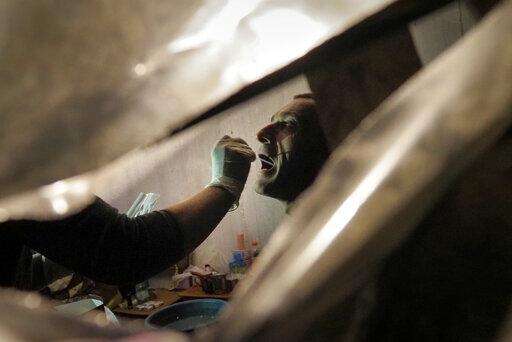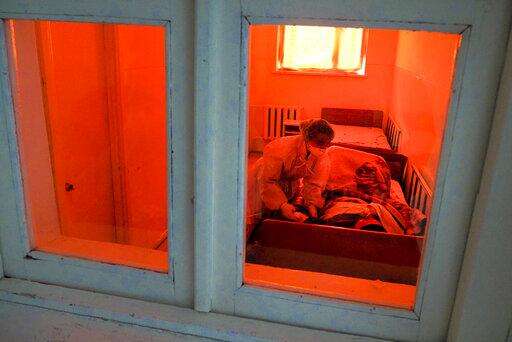Coronavirus patients lie in an infectious diseases clinic in Stepanakert, in the separatist region of Nagorno-Karabakh, Tuesday, Oct. 20, 2020.Nagorno-Karabakh, which lies within Azerbaijan but has been under the control of ethnic Armenian forces since a war there ended in 1994, faces an outbreak of the coronavirus amid the largest outbreak of hostilities in more than a quarter-century. (AP Photo)
The Associated Press
STEPANAKERT, Nagorno-Karabakh (AP) - People who are sick with the coronavirus pack into chilly basements alongside the healthy to hide from artillery fire. The local health minister who tested positive keeps working, despite a fever and pneumonia. Doctors with the virus perform surgery on the wounded.
These are the grim realities of the pandemic in Nagorno-Karabakh, a separatist region in the South Caucasus mountains beset by weeks of heavy fighting between Armenian and Azerbaijani forces.
'œWe just don't have time to think about coronavirus,'ť said Irina Musaelyan, a resident of the regional capital of Stepanakert who was sheltering in a basement with her neighbors.
Nagorno-Karabakh lies within Azerbaijan but has been under the control of ethnic Armenian forces backed by Armenia for more than a quarter-century. It is facing the largest escalation of fighting since a war there ended in 1994, with hundreds killed since Sept. 27. Two attempts at cease-fires have failed.
The fighting has diverted the region's scarce resources from containing the virus, which spread unchecked amid artillery fire and drone attacks that have people spending many hours in overcrowded bunkers, whether they are sick or healthy. Contact tracing has ground to a halt.
Health care workers have been hit particularly hard.
'œAlmost everyone got infected. Some had it in a light form and others in a more serious one,'ť Dr. Malvina Badalyan, head of the infectious disease clinic in Stepanakert, said of the region's health workers.
But in the middle of a war, with wounded flooding into hospitals, there's nothing to do but keep working.
'œMany doctors and nurses knew that they were infected, but they kept mum about it,'ť said Ararat Ohanjanyan, the health minister for Nagorno-Karabakh's regional government. 'œThey may lie down in a corner to bring the fever down and then get up and continue to perform operations.'ť
'œNo one has the right now to step aside,'ť he added.
When the the latest escalation of fighting started, medical workers had no time or resources to deal with the outbreak, Ohanjanyan said.
'œWe didn't have time to track down those infected while Stepanakert came under heavy shelling, and it allowed contagion to spread,'ť he said.
Ohanjanyan himself tested positive for the virus just over a week ago - and he, too, has continued working despite a fever and pneumonia.
In the past week, the shelling of Stepanakert has become less intense and ambulance crews have finally been able to visit shelters and basements to track down the sick, Ohanjanyan said, adding that regular testing and isolation of those infected has resumed.
Patients in the most serious condition have been sent to Armenia, while others have been admitted to hospitals or are treated at home.
Ohanjanyan said authorities still don't have a good handle on how many people are infected.
Armenia, which supports the separatist region via a land corridor, has also seen a sharp increase in cases in recent weeks. The seven-day rolling average of daily new infections has nearly tripled since early October to 44 per 100,000 people on Oct. 20.
As Nagorno-Karabakh's medical system faced the massive challenge, residents and health workers alike volunteered to deliver medicine to people sheltering in basements and to help track down those who are sick.
Dr. Aram Gregorian, who volunteered to visit those hunkered down during the shelling, said the cramped conditions in shelters helped fuel the spread of the virus.
'œConstant shelling forces people to stay in tight groups in basements, and they can't self-isolate," he said. "Even those who have a fever and clinical signs of COVID-19 can't get treatment or go to the hospital.'ť
Even coronavirus patients at the infectious disease clinic have been forced to seek shelter in the basement.
Arevik Israelyan, who was visiting her virus-stricken husband at the clinic, said the outbreak is a challenge, but people are mostly worried about the war.
'œPeople get infected, but we will live through it," she said. 'œThe main thing is that there is no war.'ť
Armenian medical workers examine a patient with suspected coronavirus in an infectious diseases clinic in Stepanakert, the separatist region of Nagorno-Karabakh, Tuesday, Oct. 20, 2020. Nagorno-Karabakh, which lies within Azerbaijan but has been under the control of ethnic Armenian forces since a war there ended in 1994, faces an outbreak of the coronavirus amid the largest outbreak of hostilities in more than a quarter-century. (AP Photo)
The Associated Press
A general view of a destroyed after shelling by Azerbaijan's artillery house during a military conflict in Stepanakert, the separatist region of Nagorno-Karabakh, Saturday, Oct. 17, 2020.Nagorno-Karabakh, which lies within Azerbaijan but has been under the control of ethnic Armenian forces since a war there ended in 1994, faces an outbreak of the coronavirus amid the largest outbreak of hostilities in more than a quarter-century. (AP Photo)
The Associated Press
Medical personnel accompany a coronavirus patient in an infectious diseases clinic in Stepanakert, the separatist region of Nagorno-Karabakh, Tuesday, Oct. 20, 2020. Nagorno-Karabakh, which lies within Azerbaijan but has been under the control of ethnic Armenian forces since a war there ended in 1994, faces an outbreak of the coronavirus amid the largest outbreak of hostilities in more than a quarter-century. (AP Photo)
The Associated Press

A medical worker collects a sample for COVID-19 testing a man inside a bomb shelter in Stepanakert, the separatist region of Nagorno-Karabakh, Tuesday, Oct. 20, 2020. People infected with COVID-19 mix with others in basements as they seek shelter from artillery fire amid the heavy fighting marking the largest outbreak of hostilities in the region in more than a quarter-century. Nagorno-Karabakh, which lies within Azerbaijan but has been under the control of ethnic Armenian forces since a war there ended in 1994, faces an outbreak of the coronavirus amid the largest outbreak of hostilities in more than a quarter-century. (AP Photo)
The Associated Press

A medic cares for a coronavirus patient in an infectious diseases clinic in Stepanakert, the separatist region of Nagorno-Karabakh, Tuesday, Oct. 20, 2020. Nagorno-Karabakh, which lies within Azerbaijan but has been under the control of ethnic Armenian forces since a war there ended in 1994, faces an outbreak of the coronavirus amid the largest outbreak of hostilities in more than a quarter-century. (AP Photo)
The Associated Press
Local citizens gather at a destroyed after shelling by Azerbaijan's artillery house during a military conflict in Stepanakert, the separatist region of Nagorno-Karabakh, Saturday, Oct. 17, 2020. Nagorno-Karabakh, which lies within Azerbaijan but has been under the control of ethnic Armenian forces since a war there ended in 1994, faces an outbreak of the coronavirus amid the largest outbreak of hostilities in more than a quarter-century. (AP Photo)
The Associated Press
A woman covers her husband, who is suspected of having coronavirus, with a blanket in an infectious diseases clinic in Stepanakert, the separatist region of Nagorno-Karabakh, Tuesday, Oct. 20, 2020.Nagorno-Karabakh, which lies within Azerbaijan but has been under the control of ethnic Armenian forces since a war there ended in 1994, faces an outbreak of the coronavirus amid the largest outbreak of hostilities in more than a quarter-century. (AP Photo)
The Associated Press
Workers repair communication lines near a house during destroyed by shelling, in Stepanakert, the separatist region of Nagorno-Karabakh, Saturday, Oct. 10, 2020. Nagorno-Karabakh, which lies within Azerbaijan but has been under the control of ethnic Armenian forces since a war there ended in 1994, faces an outbreak of the coronavirus amid the largest outbreak of hostilities in more than a quarter-century. (AP Photo)
The Associated Press
A nurse cares for a coronavirus patient in an infectious diseases clinic in Stepanakert, the separatist region of Nagorno-Karabakh, Tuesday, Oct. 20, 2020. Nagorno-Karabakh, which lies within Azerbaijan but has been under the control of ethnic Armenian forces since a war there ended in 1994, faces an outbreak of the coronavirus amid the largest outbreak of hostilities in more than a quarter-century. (AP Photo)
The Associated Press
Coronavirus patients lie in an infectious diseases clinic in Stepanakert, the separatist region of Nagorno-Karabakh, Tuesday, Oct. 20, 2020.Nagorno-Karabakh, which lies within Azerbaijan but has been under the control of ethnic Armenian forces since a war there ended in 1994, faces an outbreak of the coronavirus amid the largest outbreak of hostilities in more than a quarter-century. (AP Photo)
The Associated Press
A coronavirus patient lies in an infectious diseases clinic in Stepanakert, the separatist region of Nagorno-Karabakh, Tuesday, Oct. 20, 2020. Nagorno-Karabakh, which lies within Azerbaijan but has been under the control of ethnic Armenian forces since a war there ended in 1994, faces an outbreak of the coronavirus amid the largest outbreak of hostilities in more than a quarter-century. (AP Photo)
The Associated Press
A medical worker collects a sample for COVID-19 inside a bomb shelter in Stepanakert, the separatist region of Nagorno-Karabakh, Tuesday, Oct. 20, 2020. Nagorno-Karabakh, which lies within Azerbaijan but has been under the control of ethnic Armenian forces since a war there ended in 1994, faces an outbreak of the coronavirus amid the largest outbreak of hostilities in more than a quarter-century. (AP Photo)
The Associated Press
Doctor Aram Gregorian gives drugs to a woman near her apartment building during a military conflict in Stepanakert, the separatist region of Nagorno-Karabakh, Friday, Oct. 16, 2020. As Nagorno-Karabakh's medical system faced a massive challenge, volunteers joined the fight against the virus, delivering medicines to the people hiding in basements and helping track down those infected. (AP Photo)
The Associated Press
Malvina Badalyan, chief doctor, speaks to a patient at a clinic at the separatist region of Nagorno-Karabakh, Tuesday, Oct. 20, 2020. At Stepanakert's clinic for infectious diseases, coronavirus patients also have often had to go down to the basement to hide from shelling, chief doctor Malvina Badalyan said. (AP Photo)
The Associated Press
Volunteer doctor Eleonora Ovanesyan, right, distributes drugs to women near their apartment building during a military conflict in Stepanakert, the separatist region of Nagorno-Karabakh, Friday, Oct. 16, 2020. Nagorno-Karabakh, which lies within Azerbaijan but has been under the control of ethnic Armenian forces since a war there ended in 1994, faces an outbreak of the coronavirus amid the largest outbreak of hostilities in more than a quarter-century. (AP Photo)
The Associated Press
A nurse cares for a coronavirus patient at an infectious diseases clinic in Stepanakert, the separatist region of Nagorno-Karabakh, Tuesday, Oct. 20, 2020. Nagorno-Karabakh, which lies within Azerbaijan but has been under the control of ethnic Armenian forces since a war there ended in 1994, faces an outbreak of the coronavirus amid the largest outbreak of hostilities in more than a quarter-century. (AP Photo)
The Associated Press